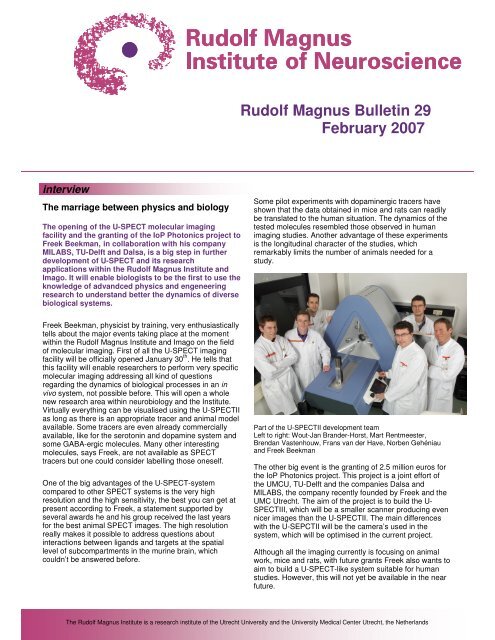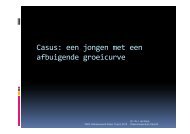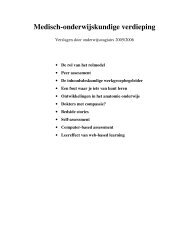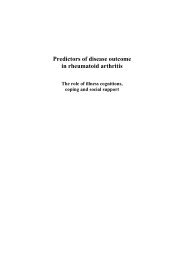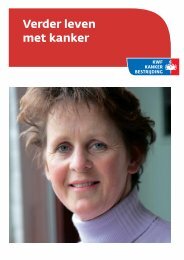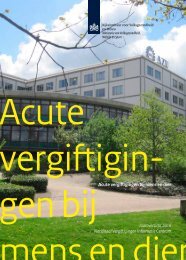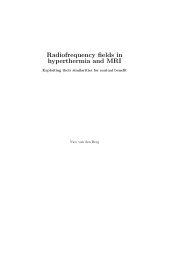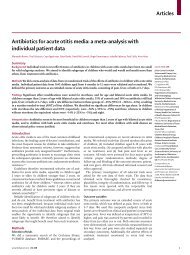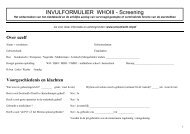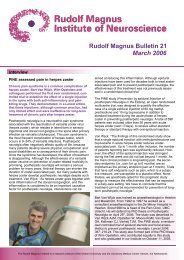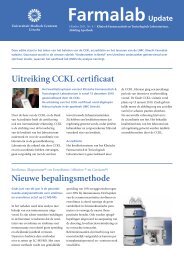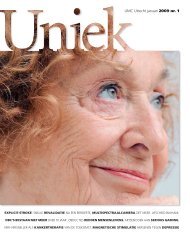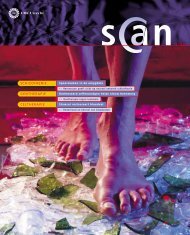Rudolf Magnus Bulletin 29 February 2007 - UMC Utrecht
Rudolf Magnus Bulletin 29 February 2007 - UMC Utrecht
Rudolf Magnus Bulletin 29 February 2007 - UMC Utrecht
Create successful ePaper yourself
Turn your PDF publications into a flip-book with our unique Google optimized e-Paper software.
<strong>Rudolf</strong> <strong>Magnus</strong> <strong>Bulletin</strong> <strong>29</strong><br />
<strong>February</strong> <strong>2007</strong><br />
interview<br />
The marriage between physics and biology<br />
The opening of the U-SPECT molecular imaging<br />
facility and the granting of the IoP Photonics project to<br />
Freek Beekman, in collaboration with his company<br />
MILABS, TU-Delft and Dalsa, is a big step in further<br />
development of U-SPECT and its research<br />
applications within the <strong>Rudolf</strong> <strong>Magnus</strong> Institute and<br />
Imago. It will enable biologists to be the first to use the<br />
knowledge of advandced physics and engeneering<br />
research to understand better the dynamics of diverse<br />
biological systems.<br />
Some pilot experiments with dopaminergic tracers have<br />
shown that the data obtained in mice and rats can readily<br />
be translated to the human situation. The dynamics of the<br />
tested molecules resembled those observed in human<br />
imaging studies. Another advantage of these experiments<br />
is the longitudinal character of the studies, which<br />
remarkably limits the number of animals needed for a<br />
study.<br />
Freek Beekman, physicist by training, very enthusiastically<br />
tells about the major events taking place at the moment<br />
within the <strong>Rudolf</strong> <strong>Magnus</strong> Institute and Imago on the field<br />
of molecular imaging. First of all the U-SPECT imaging<br />
facility will be officially opened January 30 th . He tells that<br />
this facility will enable researchers to perform very specific<br />
molecular imaging addressing all kind of questions<br />
regarding the dynamics of biological processes in an in<br />
vivo system, not possible before. This will open a whole<br />
new research area within neurobiology and the Institute.<br />
Virtually everything can be visualised using the U-SPECTII<br />
as long as there is an appropriate tracer and animal model<br />
available. Some tracers are even already commercially<br />
available, like for the serotonin and dopamine system and<br />
some GABA-ergic molecules. Many other interesting<br />
molecules, says Freek, are not available as SPECT<br />
tracers but one could consider labelling those oneself.<br />
One of the big advantages of the U-SPECT-system<br />
compared to other SPECT systems is the very high<br />
resolution and the high sensitivity, the best you can get at<br />
present according to Freek, a statement supported by<br />
several awards he and his group received the last years<br />
for the best animal SPECT images. The high resolution<br />
really makes it possible to address questions about<br />
interactions between ligands and targets at the spatial<br />
level of subcompartments in the murine brain, which<br />
couldn’t be answered before.<br />
Part of the U-SPECTII development team<br />
Left to right: Wout-Jan Brander-Horst, Mart Rentmeester,<br />
Brendan Vastenhouw, Frans van der Have, Norben Gehéniau<br />
and Freek Beekman<br />
The other big event is the granting of 2.5 million euros for<br />
the IoP Photonics project. This project is a joint effort of<br />
the <strong>UMC</strong>U, TU-Delft and the companies Dalsa and<br />
MILABS, the company recently founded by Freek and the<br />
<strong>UMC</strong> <strong>Utrecht</strong>. The aim of the project is to build the U-<br />
SPECTIII, which will be a smaller scanner producing even<br />
nicer images than the U-SPECTII. The main differences<br />
with the U-SEPCTII will be the camera’s used in the<br />
system, which will be optimised in the current project.<br />
Although all the imaging currently is focusing on animal<br />
work, mice and rats, with future grants Freek also wants to<br />
aim to build a U-SPECT-like system suitable for human<br />
studies. However, this will not yet be available in the near<br />
future.<br />
The <strong>Rudolf</strong> <strong>Magnus</strong> Institute is a research institute of the <strong>Utrecht</strong> University and the University Medical Center <strong>Utrecht</strong>, the Netherlands
What about this marriage between physics and biology?<br />
What are the real possibilities for the researchers in the<br />
<strong>Rudolf</strong> <strong>Magnus</strong> Institute? This question is very promptly<br />
answered by Freek: “Everything is possible, however, the<br />
research is very expensive and complexcostly due to<br />
costly tracers, animals and dedicated personnel involved.<br />
Therefore ad hoc studies are almost impossible to<br />
organise. Of course we are more then willing to team up<br />
and write and participate in grants, to enable making nice<br />
molecular imaging programs including high level physics<br />
and image processing support possible. A nice example of<br />
such a joint effort is the HIPO grant rewarded to Marten<br />
Smidt and me”.<br />
Visit www.milabs.com to see for yourself the possibilities of<br />
the U-SPECT-system.<br />
and are lacking with off-pump surgery. We showed that<br />
this can have obvious consequences by demonstrating a<br />
clear association between the activated hemostasis after<br />
off-pump surgery and cognitive dysfunction in the early<br />
postoperative period. In addition, we also investigated antithrombotic<br />
effects of several local anesthetics. Finally we<br />
have shown that a small elevation (clinically not<br />
noticeable) of the pre-operative inflammation marker C-<br />
reactive Protein levels predisposes a risk factor for the<br />
occurrence of atrial fibrillation after heart surgery. This<br />
applies to cardiac surgery both with and without<br />
cardiopulmonary bypass.<br />
<strong>2007</strong>-02<br />
January 25, <strong>2007</strong><br />
Herman R. Holtslag<br />
Prospects after major trauma<br />
Chr. van der Werken, E. Lindeman, M.W.M. Post and<br />
E.F. van Beek<br />
supervisors<br />
Herman Holtslag started his PhD in January 1999, after<br />
his training as physiotherapist and his medical<br />
training. He is currently employed as rehabilitation<br />
physician at the department of Rehabilitation and<br />
Sports medicine. He did his PhD training in<br />
collaboration with the department of Neurology and<br />
Neurosurgery and completed his thesis in the section<br />
of Cerebrovascular Disorders.<br />
U-SPECT image of the dopamine transporter distribution<br />
combined with overlay of the mouse brain atlas<br />
PhD theses<br />
<strong>2007</strong>-01<br />
January 18, <strong>2007</strong><br />
Bernard Lo<br />
Activation of hemostasis after off-pump coronary<br />
artery graft surgery<br />
C.J. Kalkman, R. Fijnheer and A.P. Nierich<br />
supervisors<br />
Bernard Lo started his PhD in September 2001 after he<br />
finished his medical training. He works at the<br />
department of Anaesthesiology and the department of<br />
Neurology and Neurosurgery and completed his thesis<br />
in the section of Cerebrovascular Disorders.<br />
My thesis describes among other things the impact of<br />
activation of hemostasis during two types of heart surgery:<br />
with and without use of cardiopulmonary bypass. In<br />
contrast to what has been thought for many years, our<br />
research has shown that surgical trauma plays at least as<br />
an important role in activation of hemostasis as the use of<br />
the cardiopulmonary bypass system. This may be of<br />
clinically significance in case of off-pump surgery<br />
(therefore without cardiopulmonary bypass), as the used<br />
strategies to prevent coagulation are less aggressive than<br />
with on-pump surgery. Furthermore, there are a number of<br />
anti-coagulation effects as a result of the use of the<br />
cardiopulmonary bypass, which may be clinically important<br />
Co-morbidity appeared, beside the direct impact of lesions<br />
by the accident, the most important predictor for almost all<br />
used outcome measures. Herman Holtslag, rehabilitation<br />
physician working in the <strong>UMC</strong> <strong>Utrecht</strong> and the<br />
rehabilitation centre ‘De Hoogstraat’ interviewed 335<br />
patients. All patients also completed several<br />
questionnaires. The patients are all major trauma victims,<br />
who have been primarily taken care of in the <strong>UMC</strong> <strong>Utrecht</strong><br />
in 1999 and 2000. A strong feature of this study is the<br />
prospective cohort set-up with a follow-up measurement<br />
after an average of 15 months with a high collaboration<br />
percentage (93%).The research group primarily consists of<br />
(75%) young men (37 years), who survived a traffic<br />
accident (70%), stayed one week at the intensive care unit<br />
and were dismissed after 4 weeks from the hospital. Most<br />
of the restrictions, indicated by the patients, were in the<br />
field of pain and discomfort, mobility, walking, and<br />
cognitive complaints. The consequences of these<br />
restrictions were mild to average problems in participating<br />
in the field of work, household, recreation and pastimes,<br />
and alertness behavior. Almost 40% returned partially or<br />
not at all to their job and more than 60% had stopped with<br />
their former sport or leisure activities.<br />
The impact of external causes of injuries on health has<br />
been calculated. Individuals lost 32 years of life or lived 12<br />
years with disability. Each victim contributed 25 disability<br />
adjusted life years (DALY), which put major trauma in the<br />
top 10 list of burden of diseases in the Netherlands.<br />
For the daily clinical practice as well as future research it is<br />
recommended to aim at finding the correct instrument to<br />
be able to determine the seriousness and duration of the<br />
co-morbidity in measure and number. Furthermore the<br />
attention concerning trauma patients could be intensified in<br />
the chain of prevention, relief, rehabilitation up to and<br />
including labour integration.<br />
web http://www.rudolfmagnus.nl coordination m.dekrom-3@umcutrecht.nl, phone +31 30 253 8110
<strong>2007</strong>-03<br />
<strong>February</strong> 6, <strong>2007</strong><br />
Alexander F.J.E. Vrancken<br />
Diagnositc efficiency and treatment strategy in<br />
chronic axonal polyneuropathy<br />
J.H.J. Wokke, N.C. Notermans and H. Franssen<br />
supervisors<br />
Alexander Vrancken started his PhD in September<br />
1997 after he finished his medical training. He is a<br />
resident in the department of Neurology and<br />
Neurosurgery since 2000. He completed his thesis in<br />
the section of Neuromuscular Diseases.<br />
Polyneuropathy is a common peripheral nerve disorder<br />
that often has a well known cause such as diabetes,<br />
chronic renal disease, alcohol abuse, vitamin deficiency,<br />
hypothyroidism, or use of toxic medication. Elderly people<br />
are more often affected, but the differentiation from signs<br />
of normal ageing can be difficult. It is important to<br />
diagnose a polyneuropathy and establish the cause at an<br />
early stage, because treatment can ameliorate symptoms<br />
and prevent progression. Because of the ageing<br />
population, the number of people affected by a<br />
polyneuropathy can be expected to increase. My thesis<br />
deals with questions regarding the efficient work-up and<br />
treatment strategies for chronic axonal polyneuropathy.<br />
A description of the main study results is as follows. In<br />
about 25% of healthy elderly people older than 60 years<br />
the vibration sense at the big toes or ankles and<br />
the ankle jerks can be absent, and this should be taken<br />
into account when developing a clinical diagnostic<br />
definition for polyneuropathy. Implementation of a<br />
restrictive guideline for the workup of polyneuropathy leads<br />
to less diagnostic delay (on average 2 weeks), fewer<br />
investigations and less costs (about 30%), whilst retaining<br />
diagnostic reliability. For chronic axonal polyneuropathy,<br />
the sural and superficial personal SNAP have<br />
complementary diagnostic value and equal diagnostic<br />
accuracy. Neither ageing nor disease duration have an<br />
important influence on the disease course or prognosis of<br />
chronic idiopathic axonal polyneuropathy. Sural nerve<br />
biopsies in progressive idiopathic axonal neuropathy often<br />
demonstrate inflammatory abnormalities suggestive of<br />
vasculitis (i.e. an inflammation of arterial blood vessels),<br />
but the absence of these findings does not preclude an<br />
immune-mediated origin of this neuropathy. Based on a<br />
literature review according to the methods of The<br />
Cochrane Collaboration© there is no evidence from<br />
randomized trials on which to base treatment for chronic<br />
idiopathic axonal polyneuropathy and non-systemic<br />
vasculitic neuropathy.<br />
<strong>2007</strong>-04<br />
<strong>February</strong> 7, <strong>2007</strong><br />
Carien S. de Kloet<br />
Afterwards. Neurobiological alterations in veterans<br />
with and without postraumatic stress disorder<br />
H.G.M. Westenberg, C.J. Heijnen and E. Vermetten<br />
supervisors<br />
Carien de Kloet started her PhD in June 2001 after she<br />
finished her medical training. She works at the<br />
department of Psychiatry and completed her thesis in<br />
the section Psychiatric Phenotypes.<br />
Traumatic experiences can result in long-lasting<br />
psychological dysfunction. Based on epidemiological<br />
studies we can expect that approximately 3% of Dutch<br />
military personnel will develop psychopathology in the<br />
aftermath of their deployment. My thesis focuses on the<br />
alleged hypothalamic-pituitary-adrenal axis (HPA-axis)<br />
dysregulation in posttraumatic stress disorder (PTSD). In<br />
all studies described in my thesis, we included two,<br />
sometimes three groups: Dutch veterans with PTSD,<br />
veteran controls (with the same kind of trauma exposure,<br />
but no symptoms of PTSD or other psychopathology) and<br />
healthy non military controls. This design enabled us to<br />
associate alterations in biological readouts with either<br />
trauma exposure or specific features of PTSD.<br />
The ACTH response to cognitive stress as well as baseline<br />
levels of plasma corticotrophin releasing hormone and<br />
vasopressin were specifically related to the presence of<br />
PTSD. The question remains whether these are<br />
“neurobiological markers” that develop after traumatic<br />
stress in PTSD patients or vulnerability factors that were<br />
already present before deployment.<br />
The response to the dexamethasone suppression test, the<br />
awakening cortisol response and leukocyte glucocorticoid<br />
receptor binding showed differences between veterans<br />
who experienced traumatic stress during their deployment<br />
(both PTSD patients and control veterans) and healthy<br />
controls, and might therefore be related to trauma<br />
exposure or other military related factors.<br />
PTSD patients with a comorbid depressive disorder (MDD)<br />
showed differences in the response to dexamethasone-<br />
CRH challenge and a cognitive challenge compared to<br />
PTSD patients without comorbid MDD. This suggests that<br />
we might be dealing with subtypes of PTSD, characterized<br />
by differences in HPA-axis and Sympathetic Nervous<br />
System regulation.<br />
Follow up studies assessing neurobiological and<br />
psychological parameters in patient control and<br />
prospective designs, hopefully will help to answer the<br />
questions raised in this thesis and will help to understand<br />
why some do and others do not develop mental health<br />
problems in the aftermath of traumatic stress.<br />
secretariat Universiteitsweg 100, 3584 CG <strong>Utrecht</strong>, The Netherlands, m.vandenadort@med.uu.nl, phone +31 30 253 8847
news<br />
Nick Ramsey receives prestigious VICI grant<br />
Nick Ramsey works at the department of<br />
Neurosurgery and received a prestigious VICI grant<br />
from NWO, the Dutch organisation for scientific<br />
research, titled “Human CNS Neuroprosthetics:<br />
substituting lost brain function”.<br />
Nick received the grant to investigate and develop<br />
techniques to help people who have lost their ability to<br />
speak or move. People can loose their ability to speak or<br />
move by an accident or a disease; this has a very big<br />
impact on their lives and that of their families. With his VICI<br />
grant Nick wants to develop techniques which allow those<br />
people to communicate and act using computers and other<br />
technical aids via sensors in their brains. By only thinking<br />
about a certain movement they will be able to actually<br />
move something.<br />
More about this intriguing research and the VICI grant of<br />
Nick in the next bulletin.<br />
this work, susceptibility genes for high alcohol<br />
consumption will be identified using so-called chromosome<br />
substitution strains. These strains, where single<br />
chromosomes were swapped from one strain to another,<br />
now allow for rapid identification of quantitative trait genes<br />
– in this case for high alcohol intake. The unique<br />
combination of gene expression arrays, in vivo RNA<br />
interference and QTL mapping will provide novel insight<br />
into the neurobiological mechanisms that determine high<br />
alcohol consumption and alcoholism.<br />
Example of the cages used in the experiments of Heidi<br />
<strong>Rudolf</strong> <strong>Magnus</strong> Graduate School Certificate<br />
The Director and the Research Training Committee of the<br />
Graduate School took pleasure in presenting the <strong>Rudolf</strong><br />
<strong>Magnus</strong> Graduate School Certificate to the following<br />
Doctor:<br />
Herman Holtslag (January 25, 2006)<br />
Coordinator replaced<br />
Example of sensor points in the brain<br />
Heidi Lesscher receives ‘Hersenstichting’<br />
grant<br />
Heidi Lesscher, department Pharmacology and<br />
Anatomy, received a fellowship from the Netherlands<br />
Brain Foundation for her proposal titled “Alcoholism:<br />
neurobiological mechanisms and genetic sensitivity”.<br />
Alcoholism is a complex disease with a major genetic<br />
component. The main goal of this project is to determine<br />
how the amygdala, a brain region that is well known for its<br />
role in emotional processing, promotes alcohol<br />
consumption in mice. Mice like to drink alcohol. They<br />
develop high levels of alcohol consumption after 2-3<br />
weeks of daily drinking. During her post-doctoral training at<br />
UC San Francisco, Lesscher discovered that the amygdala<br />
is critically involved in this process. With this fellowship,<br />
she will now identify the molecular mechanisms in the<br />
amygdala that facilitate high alcohol intake in mice. Using<br />
microarrays, molecular networks in the amygdala will be<br />
identified that are employed during the development of<br />
high alcohol intake. Subsequently, candidate genes will be<br />
functionally characterized by ‘knockdown’ of specific genes<br />
in the amygdala using in vivo RNA interference. Parallel to<br />
After about five years of full dedication Jan Dekker<br />
has left the <strong>Rudolf</strong> <strong>Magnus</strong> Institute to return to his<br />
‘old’ field, the science of stomach and gut. He will be<br />
the head of a group of 20 scientists working<br />
throughout the Netherlands. Jan will be based at<br />
TNO in Zeist. He can be contacted at the following<br />
email address:<br />
jan.dekker@tno.nl<br />
Since January 1 st , Mariken de Krom has replaced<br />
Jan Dekker. She can be contacted at +31030<br />
2538110, or emailed: m.dekrom-3@umcutrecht.nl<br />
agenda<br />
January 30, <strong>2007</strong>, Opening<br />
Opening U-SPECT molecular imaging facility<br />
Tuinzaal, A.A. Hijmans van den Berghgebouw,<br />
Contact, m.merseveld@umcutrceht.nl<br />
<strong>February</strong> 19 and 20, <strong>2007</strong> VCP meeting NIN<br />
Plasticity in the juvenile and adult virtual cortex<br />
NIN, Amsterdam<br />
programme and registration,<br />
www.nin.knaw.nl/IndexNIN/Meeting/ExtraPages/VCPmeeting.<strong>2007</strong>.<br />
pdf<br />
contact, martijn@cncr.vu.nl<br />
<strong>February</strong> 23, <strong>2007</strong> Helmholtz lecture<br />
Susan Lederman, (Queen’s university, Canada)<br />
‘Feeling objects, Feeling faces’zaal Rood, Ruppert building,<br />
Leuvelaan 19, <strong>Utrecht</strong><br />
16:00, contact, v.maassen@fss.uu.nl<br />
© secretariat <strong>2007</strong> <strong>Rudolf</strong> Universiteitsweg <strong>Magnus</strong> Institute 100, editor 3584 Mariken CG <strong>Utrecht</strong>, de Krom The photography Netherlands, Chris m.vandenadort@med.uu.nl, Timmers print Zuidam&Uithof phone +31 ISSN 30 253 1574-3071 8847


